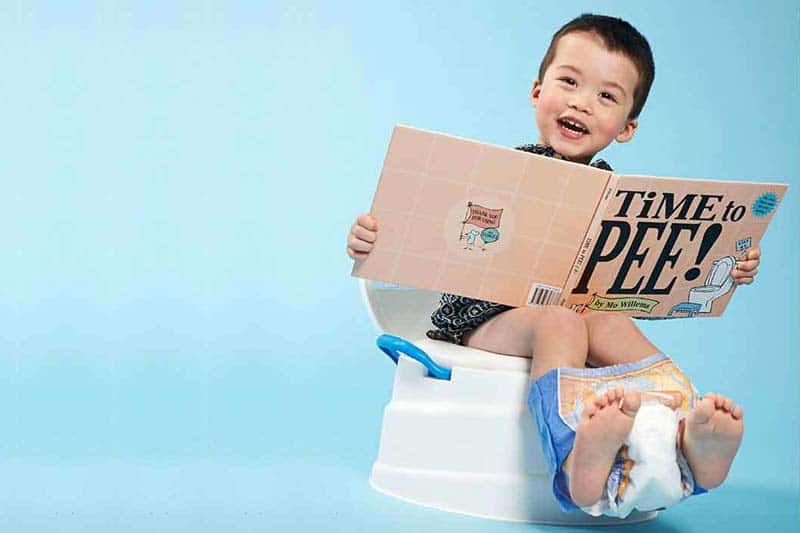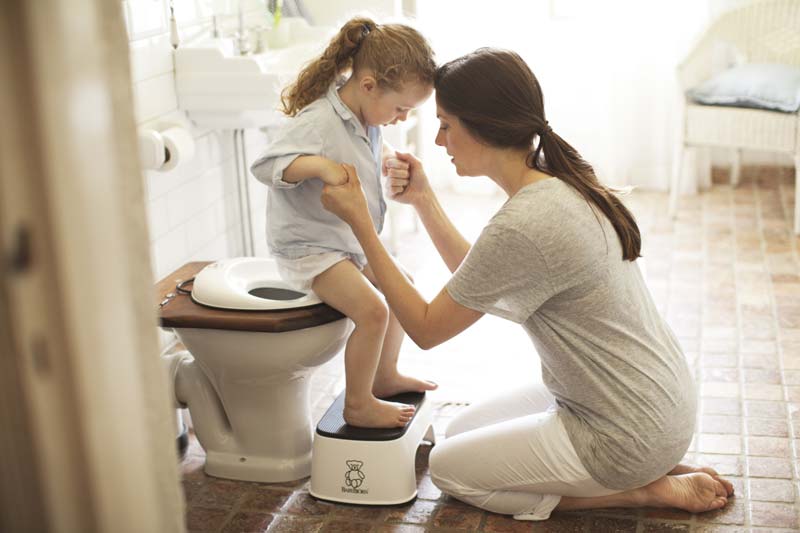Potty Training 101 – A Made Easy Guide For Parents
Potty training is arguably one of the more important events in your child’s development.
Most parents are eager to get their child to use the potty as soon as possible, just like you.
In this topic, we will talk about:
- basics of potty training
- potty training readiness checklist
- the must-haves
- challenges faced
- potty training rewards

Potty training can be a fun process too!
What is potty training?
Potty training, also known as toilet training is a process in which you train your child to use the toilet appropriately.
Mainly for urination and of course, the bigger businesses like the poo.
The term potty refers to a small toilet bowl-shaped device that helps to accommodate your child’s bum when he begins his training.
What is the potty training age?
Most children develop this skill between the age of 18 months to 3 years old.
However, it is relatively easier to train an older child rather than a younger one.
Also, it is easier to train girls rather than boys.
Most parents will want to train their children as early as possible:
- It minimizes the need to purchase diapers.
- Reduces the risks of skin irritation from a diaper rash.
- Being independent when the children are in childcare or preschool.
Potty training readiness checklist
Here is a potty training readiness checklist to see if your child is ready to be trained:
- A fixed poo-ing time.
- Diaper stays dry after 1 to 2 hours.
- Wakes up with a dry diaper.
- Interested in you going to the bathroom.
- Able to pull up and down his own pants.
- Able to understand simple instructions.
- Knows the difference between pee and poo.
- Able to tell you that he has pee’d or poo’d, or even before doing so.
- Able to show facial expressions or postures when he is about to do it.
- Enjoys praises.
- Tries his best to please you.
- Wants to do things by his own effort.
- Feels uncomfortable with his own wet/dirty diaper.
If you answer yes to most of the questions above, then your child is all ready and set to go!

The potty training itself is part of your child’s milestone development.
Potty training must-haves
Before you start to potty train your child, here are the things you might want to prepare ahead:
A potty
You can’t try a potty train a child without the most basic thing, can you?
There are a variety of potty sizes available in the market but get one that suits your child.
If a potty is too large or high, your child may feel uncomfortable and end up refusing it altogether.
A potty chair
An alternative to using a potty.
A potty chair is a kind of like the smaller version of a toilet bowl.
Your child will be able to get on and off the potty with much ease.
Besides, most children who go through potty training like to be independent, and a potty chair reinforces on that.
A travel potty
If you do travel frequently, you may want to consider getting a travel potty too.
Travel potties are equipped with a disposable bag which helps you to discard the poo without the messes.
It also creates consistency.
If your child starts to wear diapers again in the midst of potty training, you may have to start from scratch again.
A pair of training pants
Compared to diapers, training pants have a lesser absorption rate.
It indirectly creates an uncomfortable situation for your child while keeping the mess at bay.
It also helps to teach your child not to wet his pants.
Once he realizes how uncomfortable it is to walk around in a pair of wet and dirty pants, he will likely try his best not to do it again.
A toilet trainer
The toilet trainer is an equipment that can be attached on top of your regular toilet bowl.
It provides your child with a more comfortable and fitting seat to sit on when he poos instead of having his bum slipping into the bowl itself.
A stepping stool
For older children, stepping stools, especially the non-slip ones (highly recommended to avoid falls) are especially useful in helping them to get on top of the toilet seat.
It also provides the needed height for boys to stand and pee into the toilet bowl.

Having the right equipment is the key to potty training.
The best potty training seats
You want to get the best potty seat, we get it.
As simple as it sounds, we may overlook some of the details when we look for a potty for our child.
Knowing these few tips will come in handy:
Potty fit and size
Just like buying a sofa, you get the one you are most comfortable with.
Same goes to buying a potty too.
You should get one that fits your child.
A potty which is too big, or too small may cause discomfort to your child’s buttocks.
Splash guards
Particular useful for boys as boys have the tendency to pee upwards while seated down.
If you have a boy, it is advisable to get a potty with a splash guard as it minimizes mess.
Otherwise, urine may just end up everywhere else except the potty itself.
Fun features
Some potties come equipped with fun toys and gadgets that keep your child occupied.
Your child will have something to look forward to during each potty session.
However, your child may get too occupied with them that he may lose focus on the main task itself.
Ease of cleaning
Since you are going to wash the potty after use, make sure you find one that is easy to clean.
Some potties come in different parts, which can be assembled and detached after use.
Smaller parts make cleaning much easier.
Storage
Some potties are really large.
If you have minimal storage space, we suggest looking for a smaller one.
Getting a detachable potty is a plus point too.
Otherwise, that potty will just occupy a space in your home for a very long time.

Make potty training interesting.
Toddler refuses to use potty?
It is possible that your child is not ready for potty training yet.
Give him another month or two, before attempting again.
However, if your child has most of the signs stated in the checklist above, this is what you can do:
Set up a comfortable environment
Show it to your child that there is nothing scary about the toilet.
As embarrassing as it can be, you may want to keep your toilet door open when you do your business too.
This reassures him that there is nothing to be afraid of.
Subsequently, place his potty in the toilet next to the toilet bowl.
Get him to sit down with you once he is comfortable being in the toilet.
Have his favourite toys or books nearby to make him feel at ease too.
Get your child to eat healthily
You must be wondering, what does eating healthy have to do with potty training?
Well, if your child is constipated and has been passing out hard stools all these while, do you think he would be comfortable sitting on the potty?
Constipation itself may be a cause as passing out hard stools can cause pain.
If you want to know more about this, check out our guide on how to deal with your child’s constipation.
Getting your child to eat an adequate amount of fibre does help to relieve constipation.
Get your child interested
If your child likes to read, then read him books related to the toilet training.
Let him grasp the concept of using the toilet with colour pictures and stories.
If your child is not the reader-type, getting toys to simulate the scenario is beneficial too.
Once your child has an idea about a toilet, it would make potty training an easier process.
My child won’t poop on potty!
Yes, that happens!
And very often, very frustrating too but do not let that get to you.
Remember, you are dealing with a toddler, and the approach is different as compared to an older child.
Therefore, you may want to consider doing this one step at a time.
- Identify the time your child poops.
- Get your child to poop with his diapers on in the toilet.
- Next, get him to poop with the diapers on while seated on the potty.
- After that, let him know that you will loosen the strap of the diapers.
- He will still get to poop into the diapers, with the diapers overlying the potty.
- Do that a couple of times before removing the diapers completely.
- You can reinforce each step by rewarding him with a star, sticker or cookie.

It can be really stressful for a child.
Can potty training cause constipation?
Yes, it does.
If not done correctly, potty training can lead to constipation.
Why?
If your child is receiving too much pressure from your end, he may end up feeling all stressed up and will refuse to sit on the potty.
In return, your child has a greater tendency to hold his bowels which leads to constipation.
Remember to give your child the time he needs to potty train.
The earlier you potty train your child, the longer the time he takes to acquire the skill.

A reward system encourages your child to potty train.
Potty training rewards
Do not get confused with a reward and a bribe.
A reward is something you receive after accomplishing a task.
A bribe, however, works the other way round.
You give a bribe to make something happen.
A reward undoubtedly works better as compared to a bribe when it comes to potty training.
It reinforces your child’s behaviour after each successful potty training session.
A reward system is best used when your child is older, at least when he is close to 3 years of age.
As for a bribe, your child may initially agree to your request, but children being children, they may not always keep their own promises.
However, do not be hard on your child if he is unable to keep his promise.
After all, he is unable to understand what promises are all about at his current age yet.

Patience is one of the key elements in potty training.
Forcing a child to potty train
Take potty training as part of your child’s developmental milestone.
If your child is not ready, he is not ready.
Remember the time when your child started to walk independently?
Just imagine yourself trying to get him to walk when he is 6 months old, which is not possible at all.
If your child is not able to understand the idea of using the potty yet, then take a chill pill and try again later.
In the meantime, you can stimulate your child with stories and encouragement in preparation for the next training session.

Potty training a girl is generally easier than a boy.
Gender differences in potty training
Girls tend to reach their milestones quicker as compared to boys.
And again, do understand potty training is just like any other milestones.
You just have to be patient and wait for your child to acquire the particular skill set.
Apart from that, girls tend to be more concerned about their own cleanliness and hygiene as compared to the boys.
Well, no prize for guessing since it is the same for adults too.
Henceforth, girls are easier to be potty trained as compared to boys.
Now it’s your turn!
Potty training, indoubtly will take up a lot of your time, and patience if not done correctly.
- Recognize the signs that your child is ready for potty training.
- Prepare the right equipment before training.
- Start potty training only when you and your child are ready.
- Have a positive and consistent approach towards potty training.
- Potty training is a natural process and it is part of your child’s developmental milestone.
Did you manage to potty train your child successfully?
At what age did your child be able to use the potty efficiently?
Let us know in the comments below!
References:
- How to Choose the Perfect Potty | Parents
- Should we bribe our toddler to use the potty? | BabyCentre
- Potty training: How to get the job done | Mayo Clinic
- Potty training: Overview | PubMed Health
- Kiddoo, Darcie A. “Toilet Training Children: When to Start and How to Train.” CMAJ : Canadian Medical Association Journal 184.5 (2012): 511. PMC. Web. 20 Mar. 2017. | PubMed Central

Leave a Reply
Want to join the discussion?Feel free to contribute!